Page 3210 of 4087
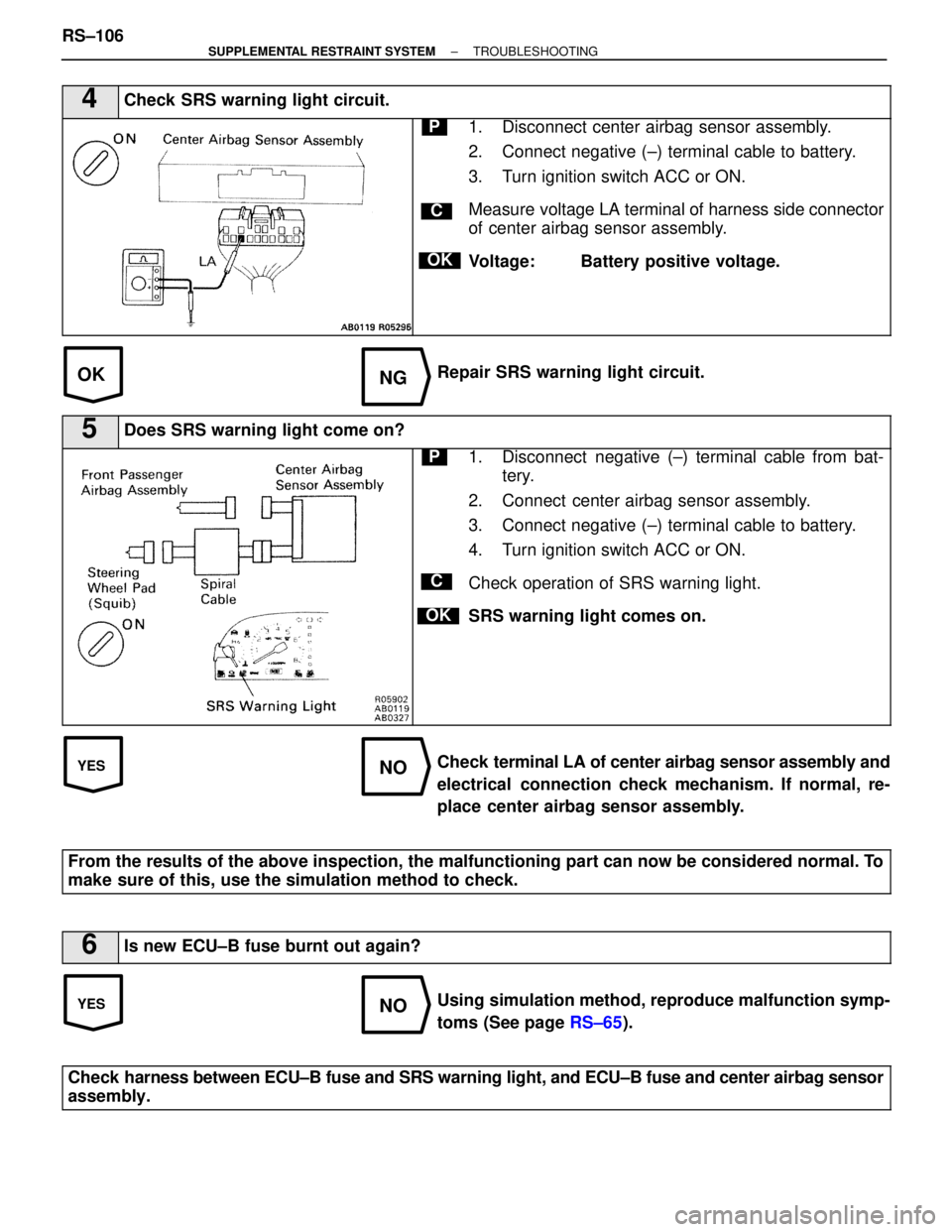
OKNG
YESNO
YESNO
4Check SRS warning light circuit.
C
OK
P1. Disconnect center airbag sensor assembly.
2. Connect negative (±) terminal cable to battery.
3. Turn ignition switch ACC or ON.
Measure voltage LA terminal of harness side connector
of center airbag sensor assembly.
Voltage: Battery positive voltage.
Repair SRS warning light circuit.
5Does SRS warning light come on?
C
OK
P1. Disconnect negative (±) terminal cable from bat-tery.
2. Connect center airbag sensor assembly.
3. Connect negative (±) terminal cable to battery.
4. Turn ignition switch ACC or ON.
Check operation of SRS warning light.
SRS warning light comes on.
Check terminal LA of center airbag sensor assembly and
electrical connection check mechanism. If normal, re-
place center airbag sensor assembly.
From the results of the above inspection, the malfunctioning part can now be\
considered normal. To
make sure of this, use the simulation method to check.
6Is new ECU±B fuse burnt out again?
Using simulation method, reproduce malfunction symp-
toms (See page RS±65).
Check harness between ECU±B fuse and SRS warning light, and ECU±B fuse a\
nd center airbag sensor
assembly.
RS±106±
SUPPLEMENTAL RESTRAINT SYSTEM TROUBLESHOOTING
WhereEverybodyKnowsYourName
Page 3217 of 4087
2. CONNECT REAR DRIVE SHAFTS
(a) Align the matchmarks on the side gear shaft and drive shafts.
(b) Apply a light coat of engine oil on the threads of the bolts.
(c) Temporarily install the 12 hexagon bolts and 4 washers.
(d) Using a hexagon wrench, torque the bolts.
Torque: 83 N Vm (850 kgf Vcm, 61 ft Vlbf)
3. INSTALL PROPELLER SHAFT
(See page PR±12 or 28)
4. FILL DIFFERENTIAL WITH OIL
Oil grade: API GL±5 Hypoid Gear Oil
Viscosity: Above±18 �C (0 �F) SAE 90
Below±18 �C (0 �F) SAE 80W±90 or 80W
Capacity:
1.35 liters (1.42 US qts, 1.19 lmp qts)
SA±84±
SUSPENSION AND AXLE REAR DIFFERENTIAL
WhereEverybodyKnowsYourName
Page 3329 of 4087
REAR DRIVE SHAFT REMOVAL
SA0S3±03
1. JACK UP VEHICLE AND REMOVE REAR WHEEL
2. REMOVE EXHAUST PIPE
3. REMOVE COTTER PIN, LOCK NUT CAP AND LOCK NUT
4. REMOVE REAR DRIVE SHAFT
(a) Place matchmarks on the drive shaft and side gear shaft.
NOTICE: Do not use a punch to mark the matchmarks. Use
paint, etc.
(b) Using a 10 mm hexagon wrench, remove the 6 hexagon bolts
and 2 washers while depressing the brake pedal.
(c) Hold the inboard joint side of the drive shaft so that the
outboard joint side does not bend too much.
(d) Using a plastic±faced hammer, lightly tap the end of the drive
shaft, disengage the axle hub and remove the drive shaft.
NOTICE:
w Be careful not to damage the boots, end cover and speed
sensor rotor of the drive shaft, and oil seal of the axle hub.
w Make sure the outboard joint side of the drive shaft does
not bend too much.
SA±66±
SUSPENSION AND AXLE REAR DRIVE SHAFT
WhereEverybodyKnowsYourName
Page 3330 of 4087
REAR DRIVE SHAFT INSTALLATION
SA0S4±02
1. INSTALL DRIVE SHAFT
(a) Insert the outboard joint side of the drive shaft to the axle hub.
NOTICE:
wBe careful not to damage the boots, end cover and speed
sensor rotor of the drive shaft, and oil seal of the axle hub.
w Make sure the outboard joint side of the drive shaft does
not bend too much.
(b) Align the matchmarks on the side gear shaft and drive shaft.
(c) Apply a light coat of engine oil on the threads of the bolt.
(d) Install the 6 hexagon bolts and 2 washers.
(e) Using a 10 mm hexagon wrench, torque the bolts.
Torque: 83 N Vm (850 kgf Vcm, 64 ft Vlbf)
2. INSTALL EXHAUST PIPE
3. INSTALL LOCK NUT, LOCK CAP AND NEW COTTER PIN
Torque: 289 N Vm (2,950 kgf Vcm, 213 ft Vlbf)
4. INSTALL REAR WHEEL AND LOWER VEHICLE
±
SUSPENSION AND AXLE REAR DRIVE SHAFTSA±67
WhereEverybodyKnowsYourName
Page 3372 of 4087
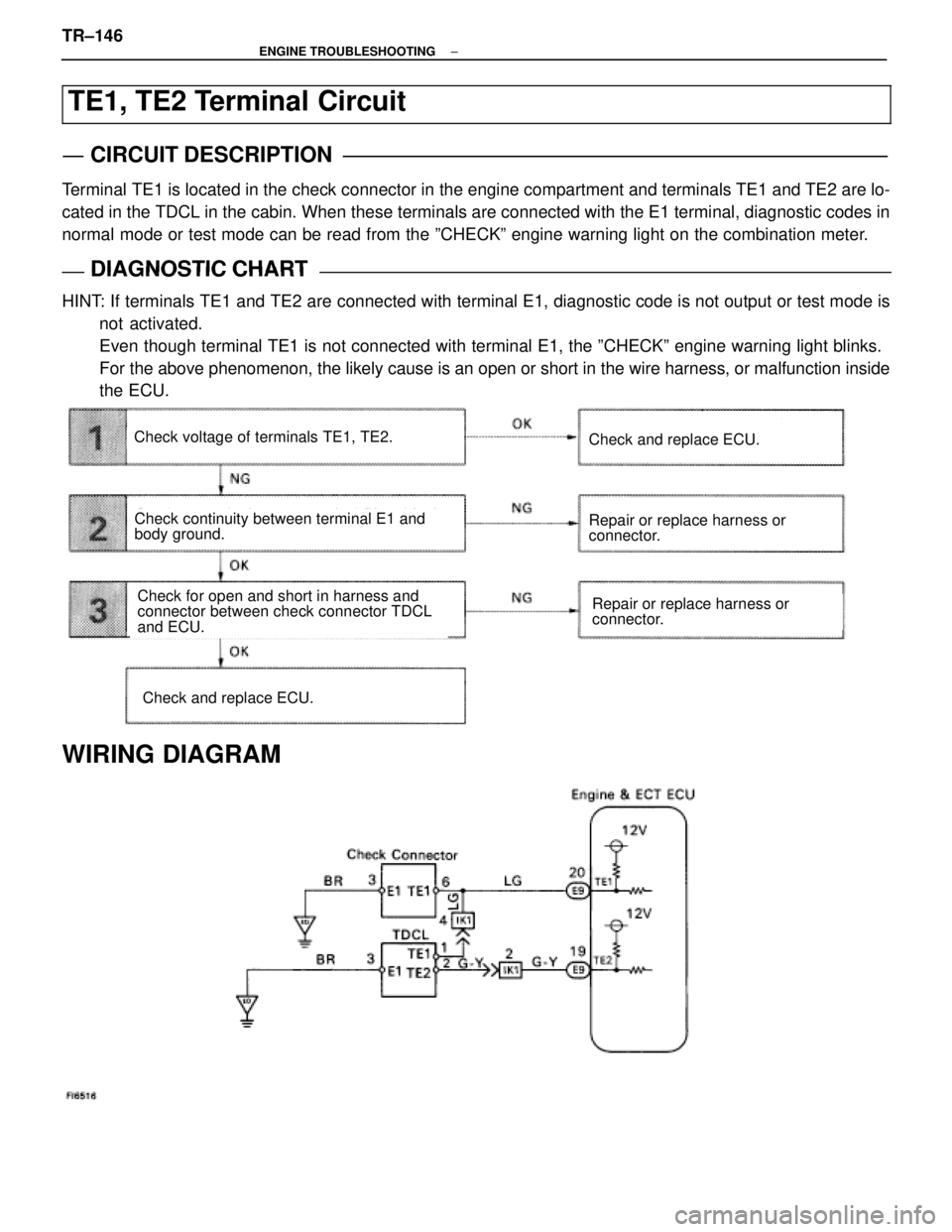
TE1, TE2 Terminal Circuit
CIRCUIT DESCRIPTION
Terminal TE1 is located in the check connector in the engine compartment and terminals T\
E1 and TE2 are lo-
cated in the TDCL in the cabin. When these terminals are connected with \
the E1 terminal, diagnostic codes in
normal mode or test mode can be read from the ºCHECKº engine warning lig\
ht on the combination meter.
DIAGNOSTIC CHARTDIAGNOSTIC CHART
HINT: If terminals TE1 and TE2 are connected with terminal E1, diagnostic code is not output or test mode isnot activated.
Even though terminal TE1 is not connected with terminal E1, the ºCHEC\
Kº engine warning light blinks.
For the above phenomenon, the likely cause is an open or short in the wire \
harness, or malfunction inside
the ECU.
Check continuity between terminal E1 and
body ground.
Repair or replace harness or
connector.Check for open and short in harness and
connector between check connector TDCL
and ECU.
Check voltage of terminals TE1, TE2.
Check and replace ECU.
Repair or replace harness or
connector.
Check and replace ECU.
WIRING DIAGRAM
TR±146±
ENGINE TROUBLESHOOTING
WhereEverybodyKnowsYourName
Page 3383 of 4087
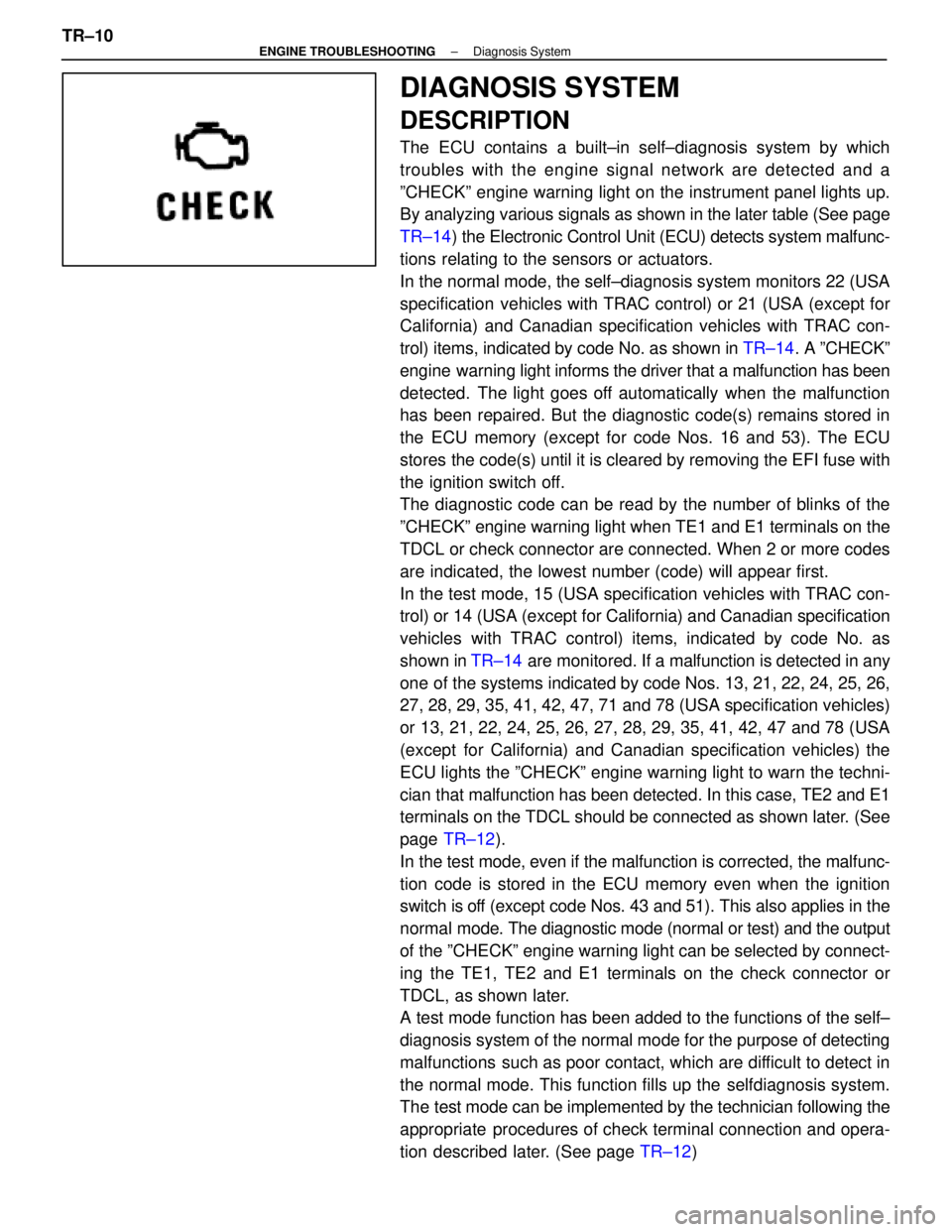
DIAGNOSIS SYSTEM
DESCRIPTION
The ECU contains a built±in self±diagnosis system by which
troubles with the engine signal network are detected and a
ºCHECKº engine warning light on the instrument panel lights up.
By analyzing various signals as shown in the later table (See page
TR±14) the Electronic Control Unit (ECU) detects system malfunc-
tions relating to the sensors or actuators.
In the normal mode, the self±diagnosis system monitors 22 (USA
specification vehicles with TRAC control) or 21 (USA (except for
California) and Canadian specification vehicles with TRAC con-
trol) items, indicated by code No. as shown in TR±14. A ºCHECKº
engine warning light informs the driver that a malfunction has been
detected. The light goes off automatically when the malfunction
has been repaired. But the diagnostic code(s) remains stored in
the ECU memory (except for code Nos. 16 and 53). The ECU
stores the code(s) until it is cleared by removing the EFI fuse with
the ignition switch off.
The diagnostic code can be read by the number of blinks of the
ºCHECKº engine warning light when TE1 and E1 terminals on the
TDCL or check connector are connected. When 2 or more codes
are indicated, the lowest number (code) will appear first.
In the test mode, 15 (USA specification vehicles with TRAC con-
trol) or 14 (USA (except for California) and Canadian specification
vehicles with TRAC control) items, indicated by code No. as
shown in TR±14 are monitored. If a malfunction is detected in any
one of the systems indicated by code Nos. 13, 21, 22, 24, 25, 26,
27, 28, 29, 35, 41, 42, 47, 71 and 78 (USA specification vehicles)
or 13, 21, 22, 24, 25, 26, 27, 28, 29, 35, 41, 42, 47 and 78 (USA
(except for California) and Canadian specification vehicles) the
ECU lights the ºCHECKº engine warning light to warn the techni-
cian that malfunction has been detected. In this case, TE2 and E1
terminals on the TDCL should be connected as shown later. (See
page TR±12 ).
In the test mode, even if the malfunction is corrected, the malfunc-
tion code is stored in the ECU memory even when the ignition
switch is off (except code Nos. 43 and 51). This also applies in the
normal mode. The diagnostic mode (normal or test) and the output
of the ºCHECKº engine warning light can be selected by connect-
ing the TE1, TE2 and E1 terminals on the check connector or
TDCL, as shown later.
A test mode function has been added to the functions of the self±
diagnosis system of the normal mode for the purpose of detecting
malfunctions such as poor contact, which are difficult to detect in
the normal mode. This function fills up the selfdiagnosis system.
The test mode can be implemented by the technician following the
appropriate procedures of check terminal connection and opera-
tion described later. (See page TR±12)
TR±10
±
ENGINE TROUBLESHOOTING Diagnosis System
WhereEverybodyKnowsYourName
Page 3384 of 4087
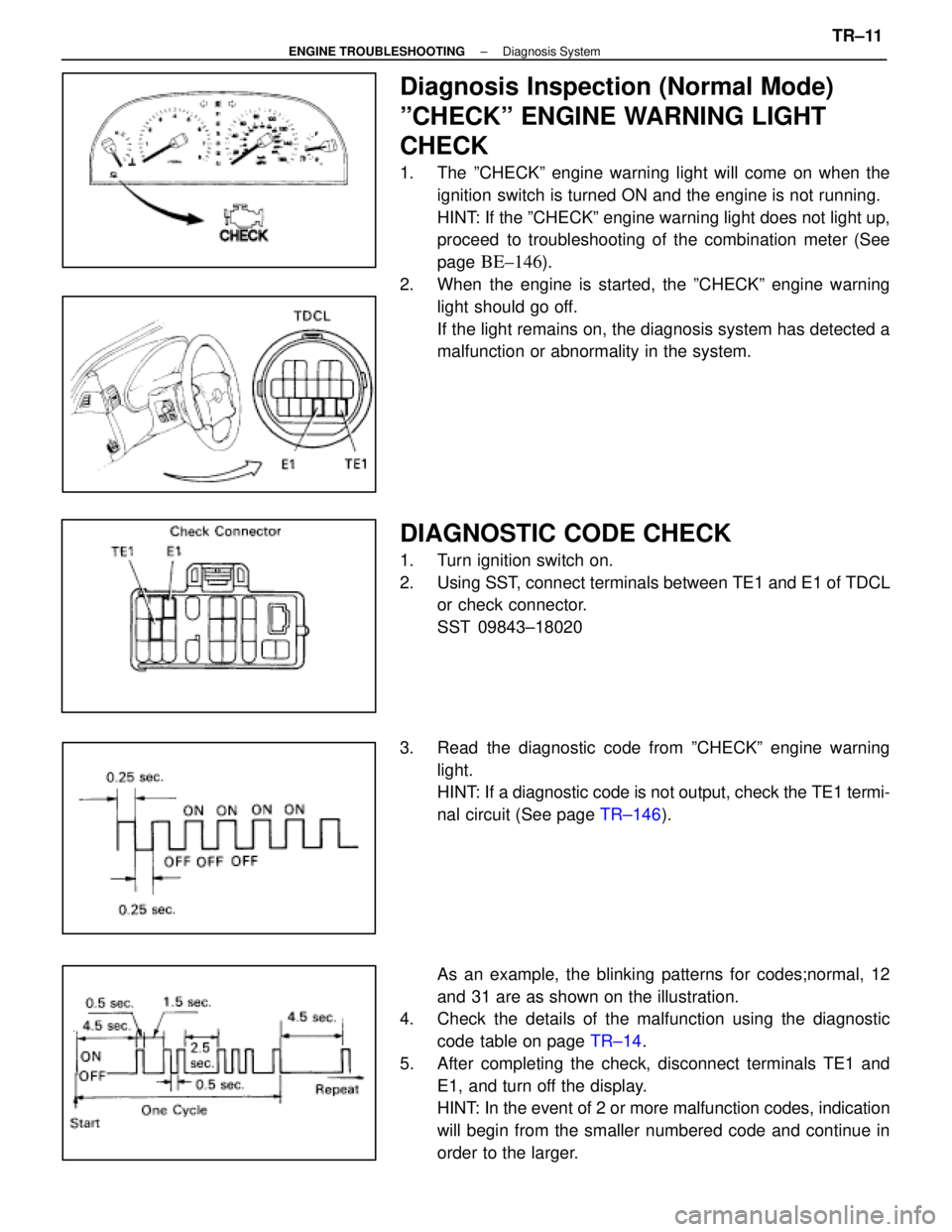
Diagnosis Inspection (Normal Mode)
ºCHECKº ENGINE WARNING LIGHT
CHECK
1. The ºCHECKº engine warning light will come on when theignition switch is turned ON and the engine is not running.
HINT: If the ºCHECKº engine warning light does not light up,
proceed to troubleshooting of the combination meter (See
page
BE±146).
2. When the engine is started, the ºCHECKº engine warning light should go off.
If the light remains on, the diagnosis system has detected a
malfunction or abnormality in the system.
DIAGNOSTIC CODE CHECK
1. Turn ignition switch on.
2. Using SST, connect terminals between TE1 and E1 of TDCLor check connector.
SST 09843±18020
3. Read the diagnostic code from ºCHECKº engine warning light.
HINT: If a diagnostic code is not output, check the TE1 termi-
nal circuit (See page TR±146).
As an example, the blinking patterns for codes;normal, 12
and 31 are as shown on the illustration.
4. Check the details of the malfunction using the diagnostic
code table on page TR±14.
5. After completing the check, disconnect terminals TE1 and E1, and turn off the display.
HINT: In the event of 2 or more malfunction codes, indication
will begin from the smaller numbered code and continue in
order to the larger.
±
ENGINE TROUBLESHOOTING Diagnosis SystemTR±11
WhereEverybodyKnowsYourName
Page 3385 of 4087
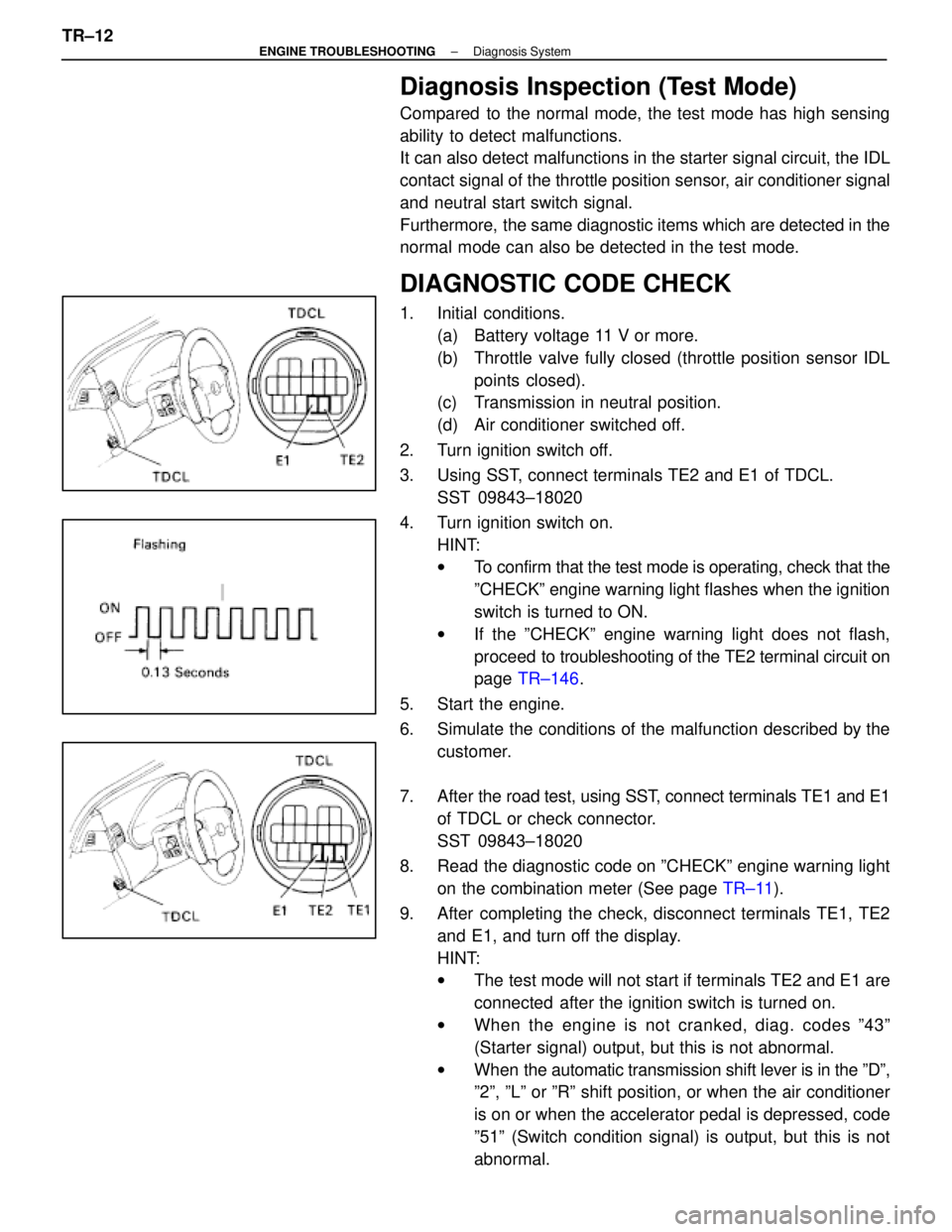
Diagnosis Inspection (Test Mode)
Compared to the normal mode, the test mode has high sensing
ability to detect malfunctions.
It can also detect malfunctions in the starter signal circuit, the IDL
contact signal of the throttle position sensor, air conditioner signal
and neutral start switch signal.
Furthermore, the same diagnostic items which are detected in the
normal mode can also be detected in the test mode.
DIAGNOSTIC CODE CHECK
1. Initial conditions.(a) Battery voltage 11 V or more.
(b) Throttle valve fully closed (throttle position sensor IDLpoints closed).
(c) Transmission in neutral position.
(d) Air conditioner switched off.
2. Turn ignition switch off.
3. Using SST, connect terminals TE2 and E1 of TDCL. SST 09843±18020
4. Turn ignition switch on. HINT:
wTo confirm that the test mode is operating, check that the
ºCHECKº engine warning light flashes when the ignition
switch is turned to ON.
w If the ºCHECKº engine warning light does not flash,
proceed to tro ubleshooting of the TE2 terminal circuit on
page TR±146 .
5. Start the engine.
6. Simulate the conditions of the malfunction described by the customer.
7. After the road test, using SST, connect terminals TE1 and E1
of TDCL or check connector.
SST 09843±18020
8. Read the diagnostic code on ºCHECKº engine warning light on the combination meter (See page TR±11).
9. After completing the check, disconnect terminals TE1, TE2 and E1, and turn off the display.
HINT:
wThe test mode will not start if terminals TE2 and E1 are
connected after the ignition switch is turned on.
w When the engine is not cranked, diag. codes º43º
(Starter signal) output, but this is not abnormal.
w When the automatic transmission shift lever is in the ºDº,
º2º, ºLº or ºRº shift position, or when the air conditioner
is on or when the accelerator pedal is depressed, code
º51º (Switch condition signal) is output, but this is not
abnormal.
TR±12
±
ENGINE TROUBLESHOOTING Diagnosis System
WhereEverybodyKnowsYourName